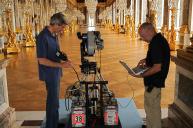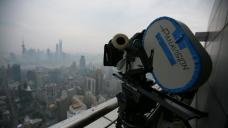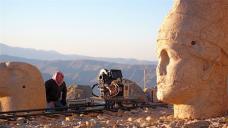
It allows to keep PV going, with more focus towards AI, but keeping be one of the few truly independent places.
-
Image quality perception is a complex subject. There is much more to it than pixel count and color depth. For an interesting explanation of one aspect (also touching on some differences between scanning a film vs. high-end digital videos - read the "Example" and the "Oversampling and downconversion" section ) see http://en.wikipedia.org/wiki/Optical_transfer_function
-
Amen to all that! In many ways digital sensors already outperform film. I get stunning results with stills with my D800 even though the sensor is just 24x36mm. Imagine if one were to pack the same 36 megapixels (sufficient for 8k video) into an IMAX frame (5x bigger than FF 35mm). The sensor's pixel wells would be 5 times bigger so you would have virtually no noise even at ISO 6400; dynamic range would be 16-17 stops; bit depth would be 16-17 bits. Film peaks at about 15 stops and falls apart at high ISO. The technology to do all this already exists - it's the manufacturing that hasn't caught up yet (yield and cost for big sensors are still issues). My guess is that we'll start seeing some high-end cameras possibly within a few years with such technology. Come to think of it - IMAX already has a 4k camera - how long before they quadruple that and use deeper A/D converters (easy to do if you liquid cool the sensor)?
-
Ten years ago or so the industry blow-hards and tech companies were trying to convince people that 35mm film had been cracked and digital now was, if not as good, better than 35mm film (all that and the cameras only shot 135Mbit 3:1:1 or 100Mbit 4:2:2). It wasn't true then and it's only partially true now if we limit the comparison to (less than)Super-35mm and a careful selection of parameters.
I could see being able to shoot straight from a 20MP equivalent sensor, to RAW, in ten years time. That would be something. It still wouldn't be close to 65mm, 5-perf or 15-perf. It would be a lot better than shooting either of those and then digitizing it though.
-
with the rate that technology is moving in general, I would say less than a decade. And the push for better cameras is also at an all time high. If somebody told you 7-8 years ago that you would be able to buy a camera with the specs of the BMCC for $3000, what would your answer have been? It feels like just yesterday I was shooting with miniDV, now I'm shooting 2.5k RAW onto SSDs lol
-
@cbrandin - You're right that digital cameras can (soon if not already) reproduce the quality shown on the web-media trailer of Samsara. But they can't yet come close to what the experience would be in seeing this film projected in a theater--especially on 70mm.
If you've ever seen a real first print from standard 35mm film (like an answer print struck directly from the cut negative, rather than going through the IP/IN process) that you would just be blown away. (Actually, I imagine you probably have seen this. Pretty awesome, huh?) Film is remarkable. Sadly, it's usually so mishandled and degraded by the time it hits the metroplex that we just don't get the full effect.
That said, I think it's a decade or less before sensors can match 70mm film, assuming all keeps going as it is. Moore's Law and all that.
-
70mm print, should only be treated in chem lab, and never scanned, there are things that must be kept the way they are. If tranfer then use a 70mm stock. Thats what i think, its like loosing all its apeal only for the sake of digital.
-
Each frame of the negative was scanned at 8k resolution on FotoKem's famous BigFoot scanner. The resulting digital data file was in excess of 20 terabytes! This large file was then compressed into 4k to create the final DCP
...that means they threw away maybe 2/3 of the actual information captured on the negative, at the initial scanning stage, if this was shot using the "small" 5-perf 65mm format.
8K is what's necessary to adequately capture all of the information in a 35mm anamorphic neg and that's only 21mm wide. DI, currently, at 4K, is least destructive to pedestrian Super-35mm content. It's an automatic lossy endeavor with anything more exotic.
65mm is still likely better handled through a traditional, photo-chemical processes, like anamorphic, unless it's meant to intercut with Super-35mm.
-
May be a small crew, but the gear is without compare. Also, the cinematographer comes from the still image world, and his visual sensibilities show that
I would also say (ripping off your line): "...beats nearly everything else I've seen with film with massive budgets!"
-
I don't disagree with what you say. I wasn't trying to compare film with low cost digital cameras - I was thinking of the high-end digital cameras. My main point was that if you are impressed with a trailer that has been digitized using H.264, there is every reason to believe that you could get similar results with a digital camera - I wasn't talking about comparing to a 70mm print. People often comment about how good Vimeo clips look - I would submit that they look good for reasons that don't require 70mm film (for example), but because of other factors; and those other factors affect the quality of digital images as well, even with low cost cameras. I'm quite sure that these beautiful images weren't created with much in the way of extreme adjustments in post to compensate for poor lighting, bad lenses, etc... I guess I would put it this way: if you like the look of the trailer, you can get results as good with a digital camera (high end, that is) - but you won't match the quality of the 70mm print.
When it comes to high ISO performance, digital sensors have the advantage. I have a Nikon D800 that takes very respectable images at ISO 3200. If you were to try to push film to that level it would look terrible. Film pushed that much becomes very grainy and has very limited dynamic range. I think you kind of acknowledged that, though.
-
You can see the grain and some noise specks on the Samsara footage in some shots. And with a crew of 3-4 people travelling light, using mostly natural sun as light source - so no fancy setups here.
Still beats anything I've seen with digital with massive budgets! But there is just an extra pop and vibrancy I really want in my next camera :(
Each frame of the negative was scanned at 8k resolution on FotoKem's famous BigFoot scanner. The resulting digital data file was in excess of 20 terabytes! This large file was then compressed into 4k to create the final DCP
It's like a classic National Geographic photo in motion!

 mark_ron_versailles_jg.jpg900 x 598 - 109K
mark_ron_versailles_jg.jpg900 x 598 - 109K
 shanghai_hg.jpg900 x 506 - 36K
shanghai_hg.jpg900 x 506 - 36K
 ron_dolly_china_hg.jpg900 x 506 - 94K
ron_dolly_china_hg.jpg900 x 506 - 94K
 MarkNemrut.jpg450 x 253 - 53K
MarkNemrut.jpg450 x 253 - 53K
 Ron%20FrickeLadakh_%20India.jpg345 x 450 - 88K
Ron%20FrickeLadakh_%20India.jpg345 x 450 - 88K -
@cbrandin - valid question. However, please consider the following two points. (also note that 1080p is related to resolution only - not color space) 1. In the digital realm, there are many factors that affect the quality of a signal, and noise is one of the bigger factors. In consumer/semi-pro systems, although they may use 10-bit or 12-bit A/D converters, the quality of the conversion will normally would be inferior to high-end electronics - even though the latter also use 12-bit conversion. In film with the fine grain quality, unless you screwed up the film chemistry or "adjust" the development process (like "pushing" the ISO up), there is no much "noise" or other artifacts to talk about (except of course high sensitivity films with coarse grain) 2. Although you theoretically compare now the results of 2 sources - digial camera and 70mm film - on a compressed stream with limited conversion qualities and gamut (your computer screen), please note that H.264 compression has normally 12-bit color space (now they also have hi-range of 14-bits), but this software process is much cleaner than a noisy 12-bit converter in a consumert camera. If the digitization of the 70mm film was done on low-noise system (which might as well be 12-bit too), then the whole path from source to target would be much less noisy and contain better color information, than a source from a digital camera.
-
I'm confused. The Samsara trailer is is a H.264 compressed 1080p digital rendering. Digital cameras will be able to produce the same quality image as the trailer you linked. If you think it looks great it's because of careful lighting,lenses, etc... Now if you were looking at a 70mm print in a theater you would see a difference that digital cameras can't reproduce.
-
@endotoxic - it is not just the GH line that will never achieve such gamut and vibrancy - all the electronic sensor-based camera that are commercially available (including the latest 4K ones) are much less color capable than 35-70mm film-based shots. The camera sensor charges are normally converted via 12-bit converters (4096 only available steps) per pixel. This is nothing compared to the millions and millions of steps available to the chemistry on film. Even if you would build a camera with 16 or even 18 bit conversion, not only you would still be far off from film quality, but the cost and power requirements of such converters would be prohibitive for even high price pro cameras.
You can get more info on the electronics involved in using sensors in cameras here: http://www.linkwitzlab.com/dpp/A-D-conversion.htm
-
@CoolColJ you're also talking about a film size that makes the sensor in the 5D/1D look small.
There is no digital equivalency for shooting in 65mm, not the small version, not the big version. There's still no digital equivalency for true anamorphic 35mm.
-
Damm this is amazing!!! 70mm film has such latitude and color, vibrant color!!! GH will never ever get close to that... :(
-
To me this is the ultimate cinematic film look - 70mm film
Rich, organic and detailed all at once - Can the GH look like this? :)
-
@kronstadt, you see - I disagree there (any image can be dissected into it´s technical and contextual substrates), but now I understand where you are coming from, as is the case with many writers/directors just like yourself. And I have absolutely nothing against anyones Personal-View. I only find it problematic when people talk about things like they were facts, omitting it´s their opinion (or from what viewpoint that is based on).. Maybe a bit of hair-splitting on my part, but I think the discussion and in particular the resource that this discussion is, benefits from clarity when it comes to those things.
Personally I do work as a DP/cinematographer - with a background in fine arts, so I have a tendency to be very analytical (and I have to avoid being too academical) at times. When I find it necessary, I go to extreme lengths to learn how stuff works. With that said, I do a lot of different stuff. Pay the bills, have fun.
The gh series let me do both. ;)
-
@RRRR There's no mystification involved. I've shot 16mm and had a brief experience with 35mm (I think it was Kodak Vision3 5219). I wouldn't say that I'm a cinematographer or a DP, I'm more of a writer/director and therefore, I mostly comment on what I see, from taste and aesthetic preference -- it's a Personal-View. As for DR on film stock, I stand corrected, indeed Vision3 have 14-15 (not 16) stops.
@feha I totally agree with you that lenses have a HUGE part to play in delivering the filmic look. I went on to create a separate topic for this http://personal-view.com/talks/discussion/5845/lenses-to-achieve-cinematicfilmiclookon-gh1-gh2-and-gh3 . I think @endotoxic and @Aria would also like that thread.
-
for me one of the best underated lenses out there are the takumar old ones. GRATE texture and color.
GH1 sensor paired with these lenses, well its magical, perfect fit.
-
@ Lenses surely play a significant role in the look of the image, and I find different lenses behave differently on different sensors, so this too, is a very big topic "outside" of this one. Maybe there already is a topic which touches upon which lenses to use for achieving "filmic" results. Or in other words, which lenses look like cine lenses and which do not.
Mind, texture can make the image from a still lens (which looks very much like a still lens) look like it wasn´t shot digitally. F.I. I think it´s possible to achieve a look with canon fd´s on gh1 / gh2 which looks a lot like documentary shot on s16mm.. (despite them being pretty contrasty very-much-stills lenses).
-
I think the choice of the lens gives that "film look", i like Nokton , than grading, framing/angles etc ... than sensor. I you use Nokton (or other "cinematic" lens) on GF2 i'm sure it gives that "film look" many samples posted already ... If you have a bad lens than sensor can't do much and vice-versa. Combination of both and more ... I like GH3 sensor for DR ...
-
I'm still at the beginning of my venture into video. I came from the Pro Audio side of things for decades. Right now I do a lot of small local TV shows, Commercials for local businesses, Wedding Videos etc. Nothing that I really felt was great work, but enough for the needs of these small local clients. I'm trying to raise my skill level for more important work. I actually like the look of the video i'm getting from my GH1.
I don't believe that the GH1 will have any problem doing the documentary work i'm looking to do in the near future. With fast lenses I feel I can get good enough exposure for just about any situation save for a cave. Especially excited about the Metabones Speed Booster combined with the GH1. I think that will make a wonderful combination. Right now I use a Vivitar 28mm F2.8 MC, Rokkor X 50mm F1.4 and Rokkor X 85mm F2. I'm still in need of more lenses to round out my kit but I find these lenses work well with the GH1. It's a very pleasing image when I use Smooth -2 all.
-
@RRR In fact you are right, i have experience in documentary making, with HPX170, HVX200, GH1, GH2, Canon 60D, t2i, 5D, and good old handycams, and from honest poin of view, HPX170 grate battle camera, grate sensor. Even though canon sensors are good for general use, they easily over expose when shoot inside rooms with windows light coming in but too much for my taste. Also its texture is too comon. Also they way it handles light..me dont like.
It would be very good idea to make topic about documentary. I cant post mines cos they belong to private corporations, but we can discuss a little bit on them, i have one short cut on one of them.
-
@endotoxic You are correct about documentary film-making.. (in that you can´t adjust too much with lighting). In general making documentaries is "easier" with cameras with a good form factor, good DR a.s.o. but plenty of people choose to shoot on cameras which do not comply with such criteria simply on the basis on desired look / feel. For shooting documentaries you´d also benefit from similar planning as a cinematographer for narrative would do. (Choosing beforehand how to handle the camera / image in different circumstances)..
I guess you have some experience from using gh-series for documentary film-making? :) (maybe a good topic for another thread, if there isn´t one already)
-
The DR of film is dependant on film-stock.. I´d like to know which stock you use @kronstadt, for 16 stops DR. Kodak vision 3 has 14, alledgedly.
And here we were discussing gh1, gh2, gh3 and the differences between the first two might be 1/3 of a stop...
Please, stop this act of trying to mystify things and put your cards on the table. What do you shoot? Do you grade / color anything you shoot?
Howdy, Stranger!
It looks like you're new here. If you want to get involved, click one of these buttons!
Categories
- Topics List23,911
- Blog5,718
- General and News1,330
- Hacks and Patches1,148
- ↳ Top Settings33
- ↳ Beginners254
- ↳ Archives402
- ↳ Hacks News and Development56
- Cameras2,342
- ↳ Panasonic984
- ↳ Canon118
- ↳ Sony154
- ↳ Nikon95
- ↳ Pentax and Samsung70
- ↳ Olympus and Fujifilm98
- ↳ Compacts and Camcorders295
- ↳ Smartphones for video96
- ↳ Pro Video Cameras191
- ↳ BlackMagic and other raw cameras116
- Skill1,959
- ↳ Business and distribution66
- ↳ Preparation, scripts and legal38
- ↳ Art149
- ↳ Import, Convert, Exporting291
- ↳ Editors190
- ↳ Effects and stunts115
- ↳ Color grading197
- ↳ Sound and Music280
- ↳ Lighting96
- ↳ Software and storage tips266
- Gear5,407
- ↳ Filters, Adapters, Matte boxes344
- ↳ Lenses1,577
- ↳ Follow focus and gears93
- ↳ Sound496
- ↳ Lighting gear313
- ↳ Camera movement230
- ↳ Gimbals and copters302
- ↳ Rigs and related stuff271
- ↳ Power solutions83
- ↳ Monitors and viewfinders339
- ↳ Tripods and fluid heads139
- ↳ Storage286
- ↳ Computers and studio gear559
- ↳ VR and 3D248
- Showcase1,859
- Marketplace2,834
- Offtopic1,314







